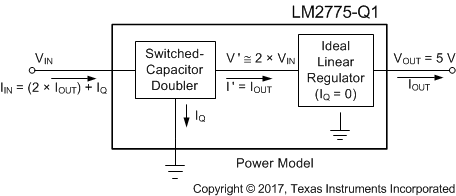SNVSAH6C June 2018 – May 2021 LM2775-Q1
PRODUCTION DATA
- 1 Features
- 2 Applications
- 3 Description
- 4 Revision History
- 5 Pin Configuration and Functions
- 6 Specifications
- 7 Detailed Description
- 8 Application and Implementation
- 9 Power Supply Recommendations
- 10Layout
- 11Device and Documentation Support
- 12Mechanical, Packaging, and Orderable Information
Package Options
Mechanical Data (Package|Pins)
- DSG|8
Thermal pad, mechanical data (Package|Pins)
- DSG|8
Orderable Information
8.2.2.3 Power Dissipation
LM2775-Q1 power dissipation (PD) is calculated simply by subtracting output power from input power:
Power dissipation increases with increased input voltage and output current, up to 1.35 W at the ends of the operating ratings (VIN = 5.5 V, IOUT = 200 mA). Internal power dissipation self-heats the device. Dissipating this amount power/heat so the LM2775-Q1 does not overheat is a demanding thermal requirement for a small surface-mount package. When soldered to a PCB with layout conducive to power dissipation, the excellent thermal properties of the WSON package enable this power to be dissipated from the LM2775-Q1 with little or no derating, even when the circuit is placed in elevated ambient temperatures.
 Figure 8-3 Power Model
Figure 8-3 Power Model